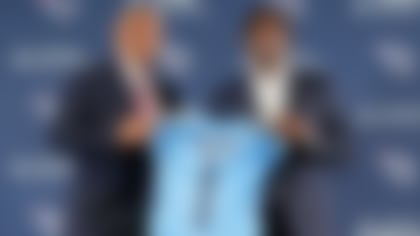OPENING DRIVE
Wes Welker said it best about Randy Moss when he told reporters after the New England Patriots' 49-28 victory over the Miami Dolphins, "He is a freak. He can just do things other receivers can't do."
It's no exaggeration to say that it is virtually impossible to cover Moss. At least, not for any length of time. He continually finds ways, legally, to separate himself from defenders on the perimeter and catch passes from Tom Brady. Even with a defensive back or two seemingly in perfect position to prevent a reception, the 6-foot-4 Moss can still extend his long arms and pluck the ball out of the air, usually for a touchdown.
Of course, Moss' 44 catches for 732 yards and a league-leading 10 touchdowns represent only part of why the Patriots routinely overwhelm opponents. Welker does plenty of damage from the slot, leading the Pats with 47 receptions. Donte' Stallworth is another game-breaking threat outside. And tight end Ben Watson, who missed the Miami game with an ankle injury, is no fun to cover, either.
So the question is this: What, besides a sudden decision by Brady to retire at midseason, can stop the Patriots' passing attack?
I posed that question to an executive of another NFL team, and his answer was simple: Hitting and weather.
"Essentially, what they're using is the run-and-shoot," he told me. "They spread the field and throw it all over the place. But Welker gets hit quite a bit over the middle. How much more of that will be able to sustain as it gets later in the season? Moss isn't going to go over the middle, so if you start to lose that inside production from Welker, defenses can concentrate more on their coverage outside.
"And you also have the weather to think about. As it gets colder, as you have to deal with more wind, rain, and snow, how effective is that passing game going to be? That's why you hardly saw any teams use the run-and-shoot. It worked great for awhile. You had the Lions putting up a lot of points in the early '90s, but then it eventually stopped."
The Lions' run-and-shoot was flying high in 1990, mainly because most of their opponents didn't see it on a regular basis and didn't know how to stop it. That all changed when they had to leave the cozy confines of the Pontiac Silverdome to face the New York Giants in late November in the Meadowlands. The Lions had scored 20 or more points in eight of their previous nine games. However, the Giants, using a defensive scheme that featured their secondary making especially hard hits on receivers underneath, wound up scoring a 20-0 victory.
By the way, their defensive coordinator at the time was current Patriots coach Bill Belichick. If anyone knows that the run-and-shoot can be stopped, he does.
Still, for seven games at least, no one -- including Mother Nature -- has presented even the slightest obstacle to hold the Pats' passing game in check.
Monday night takes
The Colts played like a team on a mission. They didn't simply set out to establish that they are clearly the best team in the competitive AFC South, although that was exactly what they accomplished with their 29-7 pounding of the Jacksonville Jaguars. They wanted to remind the entire Patriots-crazed nation that the NFL does have another dominant team worth gushing about. At 6-0, the Colts are wearing the label of defending Super Bowl champions with distinction. But they needed to show that they no longer were vulnerable against a team such as Jacksonville, which had been playing well and was a huge thorn in their side. The Colts might not be consistently blowing out opponents the way the Patriots do, but they are performing at a higher level than they were a year ago and are a far more complete team.
Sure, Peyton Manning was as efficient and effective as usual, putting the ball right on target to Reggie Wayne and his other receivers. But the biggest offensive story from this game was the Colts' rushing attack. They took command early by having Joseph Addai and Kenton Keith alternate for a combined 141 yards on 33 carries. As far as Tony Dungy was concerned, the Jaguars' 10th-ranked run defense entering Week 7 (led by behemoth tackles John Henderson and Marcus Stroud) and their tendency to put seven defenders near the line of scrimmage were reasons to run rather than constantly throw. If the Colts had given in to Jacksonville's plan to make them one-dimensional, Manning probably wouldn't have been nearly as efficient or effective a passer. He was able to easily control the game's tempo because the Jaguars' defense had to maintain respect for the running game. Perhaps the most telling stat from the game was the Colts' 34:07-25:53 in time of possession.
I still can't figure out what Jack Del Rio and his coaching staff were thinking by coming out with a pass-happy scheme and running only 10 times in the first half. Despite the Colts' substantial improvement in stopping the run, the Jaguars should have stuck with their power-oriented profile and pounded the ball all night. Did they forget that the best way to beat the Colts is to control the clock and keep their offense off the field as much as possible? And what was the thinking behind the reverse to Maurice Jones-Drew on fourth-and-1 from the Indianapolis 49 that Bob Sanders easily snuffed out late in the second quarter? If ever a situation called for a basic, up-the-middle run that Jones-Drew can execute as well as anyone in the league, that was it.
It was sad to see David Garrard suffer an ankle injury that could keep him out of multiple games. Garrard had been one of the best stories in the league, a former backup quarterback making the most of his opportunity after suddenly becoming the Jaguars' starter just before the season. Garrard is a smart passer who knows how to maintain his focus, a large reason why he has yet to throw an interception. He doesn't overreact to success or failure. The Jaguars will miss him badly, and could be headed for a tailspin if he is out for a prolonged stretch.
Random thoughts
This is what separates the Giants' Osi Umenyiora from so many other defensive ends in the NFL: Incredible speed. On his sack/forced fumble/fumble recovery/75-yard return for a touchdown in the Giants' 33-15 victory over the San Francisco 49ers, Umenyiora displayed remarkable speed from start to finish on the play. Where it showed up the most was actually at the start of the play, when he drew only a cursory contact from left tackle Jonas Jennings before lowering the boom on quarterback Trent Dilfer. "He's very fast," Dilfer told reporters after the game. "A lot of teams run that pressure and the end never gets to you in three steps. He did, obviously."
Bad idea: The Houston Texans playing man-to-man coverage and sending only one blitzer after Kerry Collins with the Tennessee Titans facing third-and-10 from their own 37-yard line with 39 seconds left and the Texans leading, 36-35. Collins was able to comfortably scan the field and step into his perfect, 46-yard throw to Roydell Williams to help set up Rob Bironas' winning field goal from 29 yards.
Great idea: The Buffalo Bills' plan to annually play a preseason and regular-season game in Toronto's Rogers Centre, beginning in 2008. It makes perfect sense for the Bills to firmly tap into a thriving economy that is responsible for at least 10 percent of the attendance at Ralph Wilson Stadium. The idea is to use the games as a magnet to attract Canadian businesses and other well-heeled types to purchase luxury suites and club seats at the Ralph, allowing the Bills to be more economically viable. Despite rampant speculation to the contrary, this is not a prelude to the Bills moving to Toronto. This is a chance for Buffalo to reap the benefits of sharing a valuable asset with its neighbors to the north, just as it does with its airport, shopping centers, and restaurants.
</center> What happened on
this day in NFL history? What is your favorite team's
all-time regular season record? Where did your team finish in the
standings in 1975? Get all this data and more on our
NFL history page.
Here's a suggestion for your football reading list: "Breaker Boys: The NFL's Greatest Team and the Stolen 1925 Championship," by David Fleming. This is the story of the 1925 Pottsville Maroons, a semi-pro team from the heart of Pennsylvania coal-mining country. After joining the then-fledgling National Football League, the Maroons put together a dominant season and seemingly won the league championship after beating the Chicago Cardinals, 21-7, in the final game of the year. However, after the Maroons played another game six days later against an all-star team from the University of Notre Dame on a neutral field in Philadelphia, league owners suspended Pottsville for playing in the territory of another NFL team and awarded the '25 title to the Cardinals. The Maroons -- whose 9-7 victory over Notre Dame and the legendary Four Horsemen was considered monumental because of college football's superiority to the pro game at the time -- have spent the past 80 years fighting to get the title back. Fleming, a senior writer for ESPN The Magazine and a columnist for ESPN.com's Page 2, does a superb job of recreating the Maroons' remarkable season and ultimate heartbreak.



